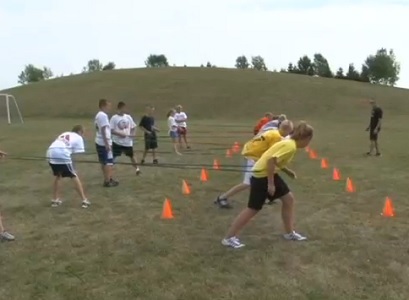Developing The Right Speed and Agility Training Programs For Young Athletes

Designing a speed and agility training program can be difficult with young athletesWithout a plan in mind of how to train a speed session, what can start as a speed session can crumble into a conditioning workout, with no lasting effects on an athlete’s ability to move quickly.

When I am coaching athletes in a youth speed and agility training program I find it necessary to first, break it down into the component parts that I would like to train, and second assess the size of the group that I will be working with.
Lets start with what we need to train.
Linear and Lateral Technique
The first thing we should address with any group of any size is the technical components that will make the athletes better and safer. For linear technique we must analyze the most common ways that linear speed are expressed:
Is it from a 3 point stance, 2 point stance, split stance, from a slower pace?
This will guide our use of acceleration training and allow us to coach the athletes on the proper start positions.
Lateral technique will focus on the lateral gait cycle and change of direction body positions. This type of training should be done with any group regardless of age and size of the group.

Linear and Lateral Power
The next phase of training will involve using different implements or tools to create more power for your athletes. Typically we will use sleds, weighted vests, medicine balls, or resistance bands to improve power in both the linear sprinting/acceleration and in lateral deceleration or acceleration

Linear and Lateral Reaction
When training reaction we are trying to improve the athletes ability to perceive the action and make the appropriate reaction. Drills in this category include change of direction with visual or verbal cues and acceleration drills on visual cues
Next lets move onto the size of the group, as this will determine the types of drills and equipment that we can use.
Less than 3 athletes
With less than 3 athletes training the coaching can be very intensive and the athletes can receive direction on technique with any and all drills. Very rarely in this situation will you be limited with the amount of equipment needed to complete a drill. Rest times will have to be accounted for through the training plan to make sure that the athletes get quality repetitions.

Small group- Less than 10-15 athletes
Training in groups smaller than 10 may limit your ability to train the group with equipment that you have on hand. If equipment is to be used it will be necessary to partner up the athletes or go in a rotation. Your ability to instruct will not be limited, but should be planned out in the training program for the day.
Large group- More than 15 athletes
With a group of more than 15 athletes restrictions on equipment become a primary concern, typically with groups this size or larger choices of equipment should be easily transportable (cones, small bands) and be plentiful. Instruction time should be mapped out before hand and should be deliberate. Large groups should be divided into smaller groups, this will allow for instruction between repetitions. Rest intervals in large groups are less necessary to plan because a normal rotation of drills and groups will allow for even, or positive rest periods.

With groups of any size it is important to approach a youth speed and agility training program with the same type of deliberate plan that is often reserved for strength training. Doing so will insure that your session will not turn into glorified conditioning work, but will instead develop real, true speed, wow coaches and grow your fitness business.
If you want to learn create your own training programs be sure to check out the Youth Speed Certification from the IYCA here;







